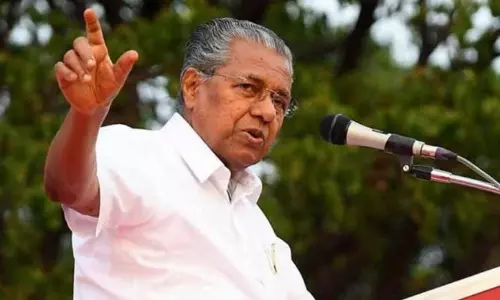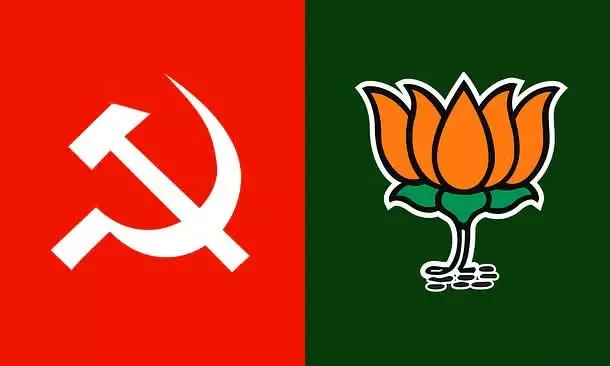
Is the Kerala Left’s leaning Right truly right-leaning?
text_fieldsIt’s quite accidental that the Indian state of Kerala, the first place in the world where the Communists came to power through the ballot, now remains the lone Indian state to be ruled by Communists out of 28. A party that once ruled three states and had a sizeable number of representatives from almost all states has now been reduced to one state. The reasons vary from the surge of right-wing Hindutva politics to the strengthening of regional politics.
Nevertheless, in Kerala, the Communist Party of India (CPI M) still tops the ranking as the biggest political party in the state. The party also made history in the 2021 legislative election by retaining power. Until then, no party or alliance could form the government for two consecutive terms. The thumping majority the party garnered and its continuity have however changed the very nature of the proletarian party too.
The recently concluded 24th state conference of CPI-M of Kerala adopted a draft resolution which indeed signals where the left party now stands. Nava Kerala Rekha or a document of new Kerala clearly shows its leaning towards capitalist principles rather than the much-touted socialist ideals of yore. No wonder a party that adopted parliamentary politics takes the road of right-wing parties is inviting more investments from domestic and foreign corporates, starting private universities, privatizing the public sector entities and imposing tolls for using the public roads – most of which the party had derided until recently.
What is more confusing is the dividing line between the right and left. A party that once took to the streets protesting against the privatization of education now shows the green signal to private universities. A party that once vehemently opposed the privatization of public sector undertakings by the Congress government earlier and the BJP government now keeps mum on the privatization of telecommunication or public transport. More alarming given the death knell of traditional communist principles is the compromise of the leftist government towards Hindutva politics.
The party Congress, which is due to begin in Tamil Nadu by next month, is going to adopt the draft resolution that distances itself from terming the right-wing Hindu nationalist government as fascist or neo-fascist. Rather, it tactically describes the BJP-led national government as showing some traits of neo-fascism. Interestingly, the Communist Party of India, CPI, differs from their close ally in defining the NDA government. It considers the BJP dispensation as fascist, and straightforward. No wonder, the BJP was quick to welcome the policy shift of CPIM.
The so-called Nava Kerala Rekha and the political policy document indicate the current position of CPIM. It's no longer a leftist as it was portrayed or the leaders want to portray it, rather, it could better be called a centrist left party with a hunger for power – that is how it goes at least for now. Or to cut it short, it’s the only available pragmatic path before it. No state government can survive without the financial support from the union government without which it will be crippled by roadblocks put by the union government. You can't go solo. Either you ally with them, or at least align with them. That’s the track the CPI-M of Kerala has adopted, unlike other opposition-ruled state governments.
A series of political developments in the state compel anyone to believe that the leftist party is in no mood to take on Hindutva fascism, even though its leadership would not admit it. The ongoing dispute over the gubernatorial powers in selecting the vice-chancellors of the university is a classic example of the compromise. Though the government had shown some disagreement with former Governor Arif Mohammad Khan, it toned down its stance towards Khan’s successor, Rajendra Arlekar. The message is clear: we are not in a fighting mood. The leftists didn’t join with the DMK-led Tamil Nadu government in its fight against the hegemony of Centre-nominated governors.
If one goes to the history of the left-ruled Indian states, one can find out the reasons behind the ideological subversion. The “people's party” slowly becomes the party of the affluent. The leader becomes dictatorial. Decades-long communist rule in West Bengal changed Jyoti Basu, the veteran communist leader into an undeclared dictator who invited multinational corporations into his state and finally, he became the last communist Chief Minister of that state – at least until now.
Coming back to Kerala, the Investors Summit, which concluded recently in Kochi is not an exception. In a way, it’s a beckoning of corporates into the state under the cover of development. A party borne out of the struggle against feudalism and battles for the downtrodden now wholeheartedly welcomes the business conglomerates and industrialists. The point here is that CPIM has chosen to flow with the water. People need more job opportunities, education on a par with international standards and a business thrust. No party can stand aloof from the voters’ expectations.
But to CPIM, it cannot renounce the precepts of Marxism explicitly nor can it shun the demands of the voters. What we see today is the balancing act between the two opposing ends.























